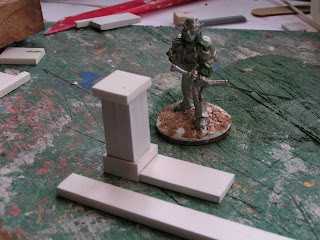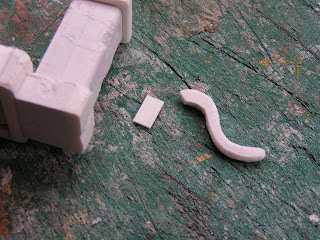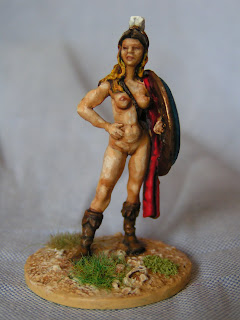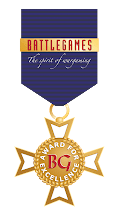As an avid model maker, particularly building wargame terrain I have a huge store of construction materials that many might find a little excessive. However this week I was given a couple of pieces of foam that at first glance looked perfect for building wargame terrain, particularly stone or brick built buildings.
While sorting out my shed-at-the-bottom-of-the-garden I thought that I would try to identify some of the many foam and resin modelling materials that I regularly use;
Photo One - White or Standard Polystyrene foam. These two examples are a thin base from a frozen pizza and a block from a packing case that I use as a 'third-hand' to hold modelling or painted figures on cocktail sticks.
Pro; Easy to obtain and comes in many intriguing shapes and firmness.
Cons; Soft and easily damaged. Does not hold carved or impressed detail well. Difficult to glue, so use either cocktail sticks or pins to strengthen uPVA bonds.

Photo Two;
Pink Foam. Used in the building trade for sound proofing and insulation. This example is from a building site skip.
Pros; Lightweight and has a more even texture (no beads or bubbles) can be carved, indented and sanded.
Cons; Once again, easily damaged and has a tendency to crumble. Difficult to glue (as above).

Photo Three;
Blue Foam. Used in the building industry and comes in a variety of different thickness. This particular image shows 20mm, 30mm and 8mm thickness.
Pros; Much firmer that the previous two, can be carved, indented, sanded and shaped easily. It will also hold these details better. One tip I will pass on is that you can press a rough stone into Blue Foam and it will preserve the stone texture perfectly.
Cons; Still easily damaged, but you have to be very 'ham-fisted' to destroy detail. Try gluing with a hot-glue gun, but still strengthen joins with cocktail sticks, pins or even bamboo skewers.

Photo Four;
Green Foam. This is a new product to me and the one that prompted this short article being given to me this week. It is much finer than Blue Foam is slightly firmer and has a powdery texture.
Pros; Still to be defined, but tests look promising. I would expect it to hold carved detail much better than Blue Foam.
Cons; Unknown at this moment.

Photo Five;
Soft Resin. Not really apparent from the photo, but this is more like soft resin, than foam. I have no idea what it is supposed to be used for but it can be cut, carved and sanded easily - it does not take pressed detail as well as blue foam.
Pros; Much firmer than foam, can be cut with a knife rather than a saw.
Cons; Too firm to have detail pressed into it and therefore all detail has to be carved into it.

Photo Six;
Soft Resin 2. This is a brittle resin slab, sorry cannot find a name for it. I have used it to make individual stones or bricks, can be sanded and is much firmer than foam.
Pros; Firmer than foam, can be carved and sanded easily and glued with superglue.
Cons; So far I have not been able to obtain any big sheets, mainly small off-cuts from a recycling centre.

Photo Seven;
Balsa Foam. I was given this block by a technical teacher from a local school. It is used for student projects and is available for artists and technical artists to build props. I use it very sparingly as it is the only block I have.
Pros; Easily cut, carved and sanded. Can be glued with suerglue and is the basis of many modelling projects.
Cons; I don't have that much, although I believe that a similar product is available via e-bay.

Photo Eight;
Hard Resin blocks. I have a few, they are very heavy and much more difficult to cut, needing a hacksaw. It can be sanded, but must be dangerous as there will be dust.
Pros; Very robust - there are different grades and strengths. Ideal where you need strength.
Cons; Not sure of the health risks connected with this one and as such is not usually my first choice of modelling material.
As stated above these are some of the wide variety of materials I use for modelling. They range from common to very rare and serve different needs. I welcome any comments relating to their names and 'official uses'.
I hope that this summary helps.
Tony



















 In part two I will describe how I based and painted this simple model.
In part two I will describe how I based and painted this simple model.








































